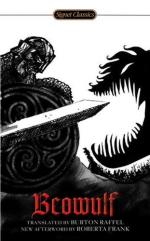|
This section contains 496 words (approx. 2 pages at 400 words per page) |

|
Beowulf Summary & Study Guide Description
Beowulf Summary & Study Guide includes comprehensive information and analysis to help you understand the book. This study guide contains the following sections:
This detailed literature summary also contains Bibliography on Beowulf by Richard Wilbur.
"Beowulf" appeared in Richard Wilbur's second volume of poetry, Ceremony and Other Poems (1950), the book that established him as one of the preeminent American poets of his generation. In this poem, Wilbur retells part of an Old English epic, or long narrative poem, also called "Beowulf." He describes the hero of the ancient poem from a mid-twentieth century point of view.
The epic "Beowulf" was written between the mid-seventh and the late tenth centuries A.D. It tells the story of a Scandinavian hero, Beowulf, who comes to save a kingdom from a monster named Grendel who attacks the castle each night. The hero fights and kills the monster; soon Grendel's mother appears, and Beowulf must defeat her as well. The Danes give Beowulf many gifts in thanks, and he returns home, where he is king of the Geats for fifty years. He eventually dies in a battle against a dragon.
Wilbur shows Beowulf as a melancholy hero. He bravely promises to fight the monster, but he also is aware that being a hero can be a lonely job. Despite his courageous deeds, he is isolated from other people, who cannot really understand him. Even the Danes, whom he saves, are remote from him. While the epic poem celebrates the heroic ideal, Wilbur's poem reveals the hero as a human being living in a less than perfect world.
Attending Amherst College in Massachusetts from 1938 to 1942, Wilbur studied literature in the then-popular method of New Criticism. New Critics encouraged poets to write in traditional forms while expressing the discord of modern life. Wilbur served as the editor of the student newspaper and published some poems, stories, and editorials in college publications. During the summers, he traveled around the country, hitchhiking and "riding the rails" - catching free rides on freight trains.
In 1942 Wilbur married Charlotte Hayes Ward, then joined the U.S. Army to serve in Europe in World War II. He began to write poems more frequently while in the army. Writing helped him, he said, make order out of the chaos he was experiencing. He sent poems to his wife and a few friends; at the end of the war these were published in his first book, The Beautiful Changes. Upon returning home, Wilbur went to graduate school at Harvard, and embarked on a university teaching career that lasted nearly forty years. In addition to teaching at Harvard, Wellesley College, Wesleyan University, and Smith College, Wilbur served as Poet Laureate of the United States from 1987 to 1988.
Wilbur is often seen as a poet of affirmation, one who has a bright and witty view of the world. "Beowulf," then, is somewhat different from the poet's other work in its tone and subject matter, though it is similar in its formal structure and musical rhythm. The power of this poem may come from Wilbur's exploration of a dark side of existence, in spite of his natural inclination to celebrate the details that make life worthwhile.
Read more from the Study Guide
|
This section contains 496 words (approx. 2 pages at 400 words per page) |

|



